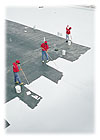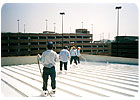Cool Roofing: Coatings Keep Things Cool
Few people doubt the value of using sunscreen to protect against sunburns and skin-damaging ultraviolet rays. Now a wide range of products are available that essentially act as sunscreens for roofing systems.

Few people doubt the value of using sunscreen to protect against sunburns and skin-damaging ultraviolet rays. Now a wide range of products are available that essentially act as sunscreens for roofing systems. As legislators, architects and building owners embrace the idea that building design has a huge impact on energy consumption and sustainability, increasingly they are recognizing that white coatings offer big benefits with few drawbacks.
A white coating consists of a binder (usually an organic polymer or silicone polymer) that is blended with pigments and other additives that provide several benefits. First, white coatings protect roof membranes with a chemical barrier and reflect sunlight, contributing to longer roof life cycles. The second benefit, of course, is that the reflection of solar radiation can result in significantly lower air conditioning costs.

Alleviating solar heating loads directly affects peak electricity requirements. Peak electric loads are often the basis for the price of electricity because they establish the energy generating needs of a region.
California Title 24 legislation requires a detailed energy audit on a new building, to show that solar heat is dissipated or removed in an energy efficient manner, e.g., through insulation and climate control systems, unless the building uses highly reflective roofing with reflectance values above 0.70. Hence, Title 24 sends a strong message to building designers: The best way to cool a building is to divert the solar energy before it raises temperatures.

The technical term for exposure is "insolation," and it is measured in terms of the rate of solar radiation received per unit area (typically expressed in Watts per square meter). Under very clear skies, up to 1,220 W/m2 of solar radiation reaches the rooftop. Imagine ordinary household hair dryers every 10 feet in both directions of a two-dimensional array: that is the intensity of the sun's energy incident upon a rooftop. Heavily insulated roof systems block this heat from penetrating the building as heat; however, in summer months, convective heat transfer to the surrounding air and radiant heat transfer are inefficient. Consequently, the heat has nowhere to go and roofing membrane temperatures can soar.
For commercial roofing systems made from organic materials, high temperatures can shorten the life of the roofing system. Rubber as well as other synthetic polymers and especially asphalt, is susceptible to damage at these elevated temperatures. Roof temperatures can rise above ambient air temperatures by as much as 90°F. Meanwhile, the rate of degradation of the roofing materials begins to accelerate at modestly elevated temperatures, for example at 140°F. Significant damage can begin to occur at these elevated temperatures, causing both short-term and long-term performance issues.
 As temperatures rise to the peak of this range, degradation of roofing systems increases exponentially. Lighter and hence more volatile organic compounds may evaporate into the atmosphere, and chemical reaction rates with water, oxygen and contaminants also increase. As a result, roof life expectancies are shortened. A rule of thumb for thermal aging is that service life is cut in half for every 18°F increase in temperature (weighted and averaged over time).
As temperatures rise to the peak of this range, degradation of roofing systems increases exponentially. Lighter and hence more volatile organic compounds may evaporate into the atmosphere, and chemical reaction rates with water, oxygen and contaminants also increase. As a result, roof life expectancies are shortened. A rule of thumb for thermal aging is that service life is cut in half for every 18°F increase in temperature (weighted and averaged over time).
Most people appreciate that white coatings result in savings on cooling costs, but enhanced roof longevity, especially in northern states, can be another major benefit that results in at least as much savings. Without white coatings, roof temperatures can skyrocket in the summer months, especially for buildings in northern climates, because they typically have a lot of insulation to help keep in the heat during the winter months.
The inverse correlation between insulation thickness and roof life is well documented by roof asset management firms. Since ripping out the insulation every summer is of course impractical, white coatings are one of the best means available to counteract the deleterious effects of high heat levels and enhance the prospects for a long-lasting roofing system.

With the growing recognition of reflectance as an important design parameter, reflectance values are being thoroughly measured across the entire solar spectrum (including infrared wavelengths) and accurate values for specific materials and coatings are becoming readily available.
 The beauty of a white coating is that the pigments, such as zinc oxide (ZnO) or titanium dioxide (TiO2), scatter a large fraction of the incident photons back into the sky, optimized for reflection in the visible and near- infrared bands. Metal-oxide pigments used in white coatings scatter light by the same mechanism that light is scattered with by the water droplets in a cloud, or fog; the scattering is due to the tiny particle size. Except for the small particle size, these materials would be transparent to light, because the metal atoms are oxidized, i.e., the valence electrons of the metals are held by the oxygen and do not interact with the incoming photons.
The beauty of a white coating is that the pigments, such as zinc oxide (ZnO) or titanium dioxide (TiO2), scatter a large fraction of the incident photons back into the sky, optimized for reflection in the visible and near- infrared bands. Metal-oxide pigments used in white coatings scatter light by the same mechanism that light is scattered with by the water droplets in a cloud, or fog; the scattering is due to the tiny particle size. Except for the small particle size, these materials would be transparent to light, because the metal atoms are oxidized, i.e., the valence electrons of the metals are held by the oxygen and do not interact with the incoming photons.
Most white coatings have a very high reflectance across all visible wavelengths and also have a high reflectance for near-infrared radiation (NIR). Typical reflectance values averaged over these wavelengths are in the neighborhood of 70 percent or 80 percent.

Photo courtesy of Firestone, an RCMA member.
Few people doubt the value of using sunscreen to protect against sunburns and skin-damaging ultraviolet rays. Now a wide range of products are available that essentially act as sunscreens for roofing systems. As legislators, architects and building owners embrace the idea that building design has a huge impact on energy consumption and sustainability, increasingly they are recognizing that white coatings offer big benefits with few drawbacks.
A white coating consists of a binder (usually an organic polymer or silicone polymer) that is blended with pigments and other additives that provide several benefits. First, white coatings protect roof membranes with a chemical barrier and reflect sunlight, contributing to longer roof life cycles. The second benefit, of course, is that the reflection of solar radiation can result in significantly lower air conditioning costs.

SPRAY APPLICATION Photo courtesy of Gardner-Gibson Inc., an RCMA member.
California Leads the Way
California is noted for taking the lead in environmental legislation, particularly in clean air and energy conservation. Recent legislation in California underscores the merits of using white coatings on commercial buildings to reduce energy costs. California Title 24 legislation is exemplary for its support of white coatings. Exempting buildings with high-reflectance roofing from energy audits makes sense because white coatings dramatically decrease the need for insulation and air conditioning.Alleviating solar heating loads directly affects peak electricity requirements. Peak electric loads are often the basis for the price of electricity because they establish the energy generating needs of a region.
California Title 24 legislation requires a detailed energy audit on a new building, to show that solar heat is dissipated or removed in an energy efficient manner, e.g., through insulation and climate control systems, unless the building uses highly reflective roofing with reflectance values above 0.70. Hence, Title 24 sends a strong message to building designers: The best way to cool a building is to divert the solar energy before it raises temperatures.

TEAMWORK Photo courtesy of United Coatings, an RCMA member.
Longevity Is Important, Too
California lawmakers deserve applause for encouraging the use of white coatings to reduce energy costs. But lower energy use is not the only benefit that accrues from the use of white coatings. White coatings can extend the life expectancy of many different types of commercial roofing systems simply by avoiding the high roof temperatures associated with exposure to the sun.The technical term for exposure is "insolation," and it is measured in terms of the rate of solar radiation received per unit area (typically expressed in Watts per square meter). Under very clear skies, up to 1,220 W/m2 of solar radiation reaches the rooftop. Imagine ordinary household hair dryers every 10 feet in both directions of a two-dimensional array: that is the intensity of the sun's energy incident upon a rooftop. Heavily insulated roof systems block this heat from penetrating the building as heat; however, in summer months, convective heat transfer to the surrounding air and radiant heat transfer are inefficient. Consequently, the heat has nowhere to go and roofing membrane temperatures can soar.
For commercial roofing systems made from organic materials, high temperatures can shorten the life of the roofing system. Rubber as well as other synthetic polymers and especially asphalt, is susceptible to damage at these elevated temperatures. Roof temperatures can rise above ambient air temperatures by as much as 90°F. Meanwhile, the rate of degradation of the roofing materials begins to accelerate at modestly elevated temperatures, for example at 140°F. Significant damage can begin to occur at these elevated temperatures, causing both short-term and long-term performance issues.

VERSATILITY Photo courtesy of RCMA.
Most people appreciate that white coatings result in savings on cooling costs, but enhanced roof longevity, especially in northern states, can be another major benefit that results in at least as much savings. Without white coatings, roof temperatures can skyrocket in the summer months, especially for buildings in northern climates, because they typically have a lot of insulation to help keep in the heat during the winter months.
The inverse correlation between insulation thickness and roof life is well documented by roof asset management firms. Since ripping out the insulation every summer is of course impractical, white coatings are one of the best means available to counteract the deleterious effects of high heat levels and enhance the prospects for a long-lasting roofing system.

APARTMENT ROOF Photo courtesy of United Coatings, an RCMA member.
The Future Is Now
Reflectance is measured according to strict standards. A perfect reflector would have a value of 100 percent for all wavelengths of light; when just one value of reflectance is given, it usually represents an average value weighted according to intensity across the solar spectrum.With the growing recognition of reflectance as an important design parameter, reflectance values are being thoroughly measured across the entire solar spectrum (including infrared wavelengths) and accurate values for specific materials and coatings are becoming readily available.

COMMERCIAL ROOF Photo courtesy of United Coatings, an RCMA member.
Most white coatings have a very high reflectance across all visible wavelengths and also have a high reflectance for near-infrared radiation (NIR). Typical reflectance values averaged over these wavelengths are in the neighborhood of 70 percent or 80 percent.
Looking for a reprint of this article?
From high-res PDFs to custom plaques, order your copy today!




